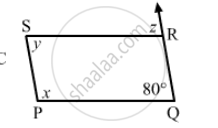Advertisements
Advertisements
प्रश्न
The given figure shows a rhombus ABCD in which angle BCD = 80°. Find angles x and y.

उत्तर
In rhombus ABCD, diagonals AC and BD bisect each other at 90°
∠BCD = 80°
Diagonals bisect the opposite angles also ∠BCD =
∠BAD (Opposite angles of rhombus)
∠BAD = 80° and ∠ABC = ∠ADC = 180° – 80° = 100°
Diagonals bisect opposite angles
∠OCB or ∠PCB =`80^circ/2` = 40°
In ∆PCM,
Ext. CPD = ∠OCB + ∠PMC
110° = 40° + x
⇒ x = 110° – 40° = 70°
and ∠ADO = `1/2` ∠ADC = `1/2 xx 100^circ = 50^circ`
Hence x = 70° and y = 50°
APPEARS IN
संबंधित प्रश्न
Name the quadrilaterals whose diagonals are perpendicular bisectors of each other
The following figure is parallelogram. Find the degree values of the unknown x, y, z.

If an angle of a parallelogram is two-third of its adjacent angle, find the angles of the parallelogram.
Which of the following statement is true for a rhombus?
Its diagonals are equal and perpendicular.
The diagonals of a parallelogram are not perpendicular. Is it a rhombus? Why or why not?
If the diagonals of a rhombus are 12 cm and 16cm, find the length of each side.
One side of a rhombus is of length 4 cm and the length of an altitude is 3.2 cm. Draw the rhombus.
Draw a rhombus ABCD, if AB = 6 cm and AC = 5 cm.
Lengths of diagonals of a rhombus ABCD are 16 cm and 12 cm. Find the side and perimeter of the rhombus.
ABCD is a rhombus. If ∠BCA = 35°. find ∠ADC.
